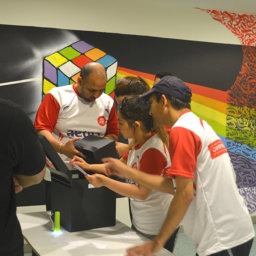
One of the most vexing challenges facing any leader in a business environment is building better working relationships with his/her team. It’s a demanding, time-intensive challenge, both personally and professionally. Inevitably, it involves making mistakes, learning along the way, and celebrating success when it occurs.
One of the keys to better working relationships as quickly as possible is getting to know your team well. Build up a picture in your mind of each member of your team. Doing so, you will discover that each requires a slightly different approach to building that relationship.
Your success as a leader will inevitably be judged by your team’s results. And those results can typically be viewed as a reflection of your relationships with the people in your team delivering those results.
However, one of the great paradoxes of leadership is that the most effective way to build better working relationships lies in forging those close working ties without your team even realizing you are doing it.
7 Ways To Build Better Working Relationships To Ensure Outstanding Team Performance
-
Ask Questions
This mode of communicating confers several benefits. Firstly, it signals your personal and professional interest in your team. Adopting a questioning, coaching model of leadership also gives your team members permission to be solution-focused. This, in turn, empowers those individuals.
Questions can encourage a culture of exploration and innovation among team members. This is especially so if your approach digs deeper than simply accepting the status quo.
A team culture that asks questions may also be more prepared to ‘try’ and thus risk failure more often. A leader, who inspires others to take risks and be comfortable with ‘failure’, while at the same time supporting them, inspires tremendous loyalty.
-
Develop Shared Values.
Values are the typically unspoken rules by which we act in the workplace. They govern our behaviour and our mindset. When a group of people espouse a common set of agreed values and understand which behaviours support those values, then it becomes relatively simple for them to live up to those values.
Devoting time as a leader to establishing the team’s values not only builds great relationships between you and the team but also across the broader organisation as well.
It’s a highly effective method of cementing a common bond between team members. However, to do this effectively, you need to understand your own values!
-
Set High Expectations
Setting expectations is a central part of orienting a team around shared values, common behaviours, and results. Expectations actively shape team culture. One way to ensure everyone knows what is expected of them is to simply tell them.
Don’t be afraid of sharing your expectations and ensure you demonstrate these daily. Setting expectations also allow roles to be clarified and success to be visualized. Consequently, this also empowers individuals to make the most of their skills and experience.
This also demonstrates your belief in your team. Once you understand your team’s individual strengths, then setting challenging goals can help everyone grow and develop.
-
Use Praise, It’s Free
Praise can be a powerful motivator when it is authentic. It evokes positive emotions and can boost performance. Research indicates employees who received regular praise and recognition responded with increased productivity. They also engage more frequently with colleagues and were less likely to leave an organization.
The key, though, is that praise has to be “authentic.” Any feedback should be specific and constructive. Sound leaders should be capable of clearly identifying what a team member does that is effective and how it contributes to the team’s overall performance.
Leaders who share their insights boost the positive emotions of their team members. This enables the team to understand each other’s strengths, as well as with people in the organisation outside of your department.
This, in turn, increases the team’s visibility and reputation within the organisation. Growing your team members and facilitating their career success is a savvy rapport-building skill. This also reflects well on you as a leader, as it shows you have the ability to inspire and drive team performance.
-
Build A Listening Culture
Much has been written about being an active listener. It’s a key pillar in building interpersonal rapport with individual team members. This includes focusing your full attention on the person in front of you, minimizing distractions, reflecting back positive emotions, and confirming your understanding by asking insightful questions.
Another way to harness the power of a listening culture is to run meetings in a way that ensures everyone has a voice. Ensure everyone feels listened to as well. Allow your people space and time to think. Access their own ideas before offering yours. Allowing everyone an uninterrupted turn to speak, allow people in your team to feel listened to. This will also give you useful insights into your team’s psyche.
-
Recognize Emotions in Others
Developing “Emotional Intelligence” is a very useful skill to cultivate as a leader. One aspect of this involves being able to diagnose emotions, both personally and in other people.
The innate ability to see and respond to others’ often unspoken feelings is at the heart of compassionate connections. Faces are the best places in which to read our emotions. They offer a window into how we’re really feeling. Learn to recognize those micro-expressions, which enables us to connect more fully with one another. Respectfully recognizing another’s emotional state positions a leader to demonstrate empathy and alter the way she or he communicates in order to be heard.
-
Be A Leader
Teams desperately desire leadership, not a friend who enjoys spreading office gossip. A leader’s role is not to be everyone’s best friend. A leader’s role is to provide direction and behave in a way that inspires trust and confidence.
A leader provides their team with vision and objectivity, standing outside the day-to-day tumult of frustrations and tasks. Clarity and bringing a broader, deeper perspective of what’s happening within the team to bear on a situation is an essential part of leadership.
In order to be effective in their role, a leader needs to understand their own leadership style, appreciate the often-intangible qualities inherent in the leadership role, and master the complex demands of serving as well as leading others.
If you can demonstrate you are someone your team can trust and rely on to consistently show fairness, empathy, and compassion, this will transform your team into a safe working environment and foster better working relationships.
Be A Smart Team Leader and Unlock The Secrets To Productivity And Enhanced Teamwork
Nurturing teamwork and clear communication is the key to building a high-performing organization.
Download the FREE Team Leader’s Guide To Instant 10X Team Productivity NOW!
Final Word
The most effective leaders are those that find a way to nurture better working relationships with their team members. Regardless of your team’s purpose, or its position in the organizational structure, cementing effective and better working relationships with your team is crucial if you want to consistently deliver results, fast. So taking time and investing at least part of your focus on creating a trusting connection based on fostering rapport, encouraging open, transparent communications, and valuing outstanding performance, will help you build not only better working relationships with your team, but also a solid foundation for success.

















[…] activities have long been part of office life. They nurture better working relationships between employees and their teams, encourage open communication, and help forge bonds that might […]